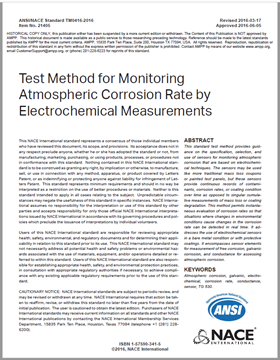Search
Test Method
View as
Sort by
Display
per page
ANSI/NACE TM0416-2016, “Test Method for Monitoring Atmospheric Corrosion Rate by Electrochemical Measurements”
Product Number:
21405-SG
Publication Date:
2016
$179.00
ANSI/NACE TM0416-2023/ISO 22858:2020, Corrosion of metals and alloys — Electrochemical measurements — Test method for monitoring atmospheric corrosion
Product Number:
ANSI-NACE TM0416-2023-ISO 22858-2020
$149.00
Case Study - Coating Failure or Building Failure
Product Number:
51216-015-SG
Publication Date:
2016
$20.00
Comparing Multiple Weathering Techniques Among Various Coatings Chemistries
Product Number:
41213-762-SG
Publication Date:
2013
$20.00
Design Of Cathodic Protection System For Duplex Stainless-Steel Pipeline: Protection Criteria And Hydrogen Embrittlement Management
Product Number:
51322-18124-SG
Publication Date:
2022
$20.00
Development and Implementation of a Novel Method to Remove Inorganic Zinc Coating from Low Alloy Steel
Product Number:
41215-913-SG
Publication Date:
2015
$20.00
Developments In Abrasive Blast Nozzle Technology: Reducing Noise Exposure While Preserving Nozzle Performance And Usability
Product Number:
51322-18086-SG
Publication Date:
2022
$20.00
Effects of Scratch Defects in Epoxy Coating of Steel Reinforcing Bars Embedded in Structural Concrete
Product Number:
41216-968-SG
Publication Date:
2016
$20.00
Endurance Regression Testing: A Method to Replace ASTM D2992
Product Number:
51317--9208-SG
ISBN:
9208 2017 CP
Publication Date:
2017
$20.00
Epoxy Penetrating Sealer Over Latex Acrylic - Good or Bad?
Product Number:
41215-934-SG
Publication Date:
2015
$20.00












